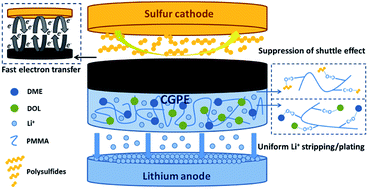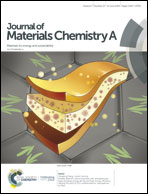An acetylene black modified gel polymer electrolyte for high-performance lithium–sulfur batteries†
Abstract
Lithium–sulfur (Li–S) batteries are considered to be a promising energy storage system for the future. However, a series of problems, such as sulfur acting as an insulator, the shuttle effect and the growth of lithium dendrites, have hindered their commercial application. To simultaneously tackle these three challenges, a composite quasi-solid/gel polymer electrolyte consisting of a nonporous supporting layer made by lightly cross-linked PMMA and a coated acetylene black layer was prepared to realize high-performance Li–S batteries. The nonporous polymer membrane was used to efficiently suppress the growth of lithium dendrites and promote the formation of a stable solid electrolyte interphase, while the acetylene black layer facing the sulfur cathode can hinder the polysulfide diffusion and promote rapid electron transfer. The as-prepared lithium–sulfur batteries show good cycling stability for 200 cycles, with an initial specific capacity of 994.5 mA h g−1 at 1C and perfect rate performance with a reversible capacity of 657.5 mA h g−1 at 3C. The growth of lithium dendrites was also effectively suppressed. This work provides a new concept for the structural design of Li–S batteries and promises to promote the further commercialization of Li–S batteries.



 Please wait while we load your content...
Please wait while we load your content...